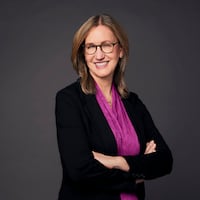Veteran investigative reporter Danny Robbins was researching another story when he came across public documents he couldn’t ignore. Doctors in Georgia, he found, were getting caught sexually abusing their patients, and they weren’t being shut out of medicine. In fact, state licensing officials let most of them keep practicing.
At the time, doctor sexual misconduct was seen as an anomaly, not a national problem. But Robbins kept looking and found more cases than he expected. And those cases reminded him of how the church once quietly dealt with priests who molested kids, or how schools once ignored allegations about abusive coaches. Robbins and his editor, Lois Norder, knew they had a story to share with Georgia readers. But they immediately wondered: Did medical regulators in other states forgive sexually abusive doctors too?
In this era of "big data," Robbins, Norder and others on the AJC's investigative team hoped to obtain information from across the country in electronic formats that would identify which doctors were disciplined and why. After filing public records requests with the 64 state agencies that license or discipline doctors in every state, reporters found that those kind of databases weren't kept.
So, the investigative team got data journalists John Perry and Jeff Ernsthausen involved. They took the only feasible reporting path: They resorted to “scraping” public disciplinary orders from regulators’ websites. This entailed writing computer programs for each one. That process, which took weeks, gathered more than 100,000 documents. Then to assist in identifying the ones that might involve sexual misconduct, Ernsthausen created a computer program based on “machine learning.” The program analyzed each document, searching for keywords, to identify those most likely to indicate sexual misconduct.
That high-tech reporting narrowed the number of documents that had to be reviewed to about 10,000, a more feasible but still-difficult reporting task. Norder and Robbins, along with staff writers Carrie Teegardin and Ariel Hart, came to work every morning with a mission: reading case after case. Everyone selected a state or two to start, poured large cups of coffee and hunkered down. Some documents were as short as a page or two, but many others were 200 pages or longer. The tool built by Ernsthausen also allowed them to code and categorize doctor records as they read.
The reporters knew the process would take months. But the team soon realized something else: They were exploring the inner workings of a shocking physician discipline system that needed to be exposed. The importance of the story rested in the details of the cases, which covered everything from anesthesiologists who raped and fondled unconscious patients to ob-gyns who penetrated women during exams to psychiatrists who lured child-abuse victims into sexual relationships. Doctors frequently targeted vulnerable victims, including those addicted to prescription drugs and some with profound mental disabilities.
Many of the acts were chilling: a doctor asking patients to parade around an exam room completely nude, a doctor telling a young patient she needed a pelvic exam when she came in for a sore throat, a doctor who placed his mouth on a patient’s genitals during the middle of an exam or another who pulled down his own pants and exposed himself to a patient. It was hard to believe the facts — and also hard to accept the results: Often, the victims weren’t believed. And often, doctor-dominated medical boards would find ways to keep the abusive doctors in practice.
Ultimately, the AJC team identified more than 3,100 doctors who were publicly disciplined since the beginning of 1999 for sexual misconduct, 2,400 in cases involving patients. But they also discovered that many, if not most, cases of physician sexual misconduct remained hidden, as hospitals didn’t alert medical regulators, or regulators handled the cases in private, if at all.
The team expanded as more shoe-leather reporting was required. Investigative reporters Alan Judd and Johnny Edwards joined to help. Public disciplinary documents don’t name victims, so the reporting team starting looking for other documents and sources to find the patients who had been assaulted. The reporters worked the phones and literally knocked on doors across the country, to talk to patients and doctors.
Some victims were relieved to tell their stories to the AJC’s reporters and video journalist Ryon Horne. For years, many said, nobody believed them. Many more victims were still too afraid or too uncomfortable to speak publicly. The reporters spent hours on the phone with individual patients, assuring them their stories would be taken seriously and could make a difference.
Ultimately, team members traveled to about a dozen states for their work. All along, graphic artist Richard Watkins worked closely with the reporting team and conducted independent research, as he developed illustrations to anchor the series.
To understand the legal environment for disciplining doctors, the team read laws in all 50 states and the District of Columbia, then provided every medical board with findings so that each could comment.
Newsroom specialists developed a standalone website, doctors.ajc.com, for the comprehensive report. Each state has a page that includes laws and regulations governing doctors, instructions on how to make a complaint, and a comparison of patient protection with other states.
The Atlanta Journal-Constitution usually provides premium journalism behind a paywall, but the public service of this series was too important to limit to subscribers.
Today’s story is the final installment in the series, highlighting the culture that has tolerated physician sexual abuse even in the most blatant cases. If you’ve missed earlier installments, all the stories, videos and other content are at doctors.ajc.com.
Within a few hours of publishing the first part of the series, the first email came in from a reader. Many like it would follow. "I am so glad you are bringing this to light," the reader wrote. "I was sexually abused by a doctor in St. Louis when I was in my mid-20s. I was so shocked and humiliated, I did not report it or even tell my husband, and I did not go near any doctors after that for about 10 years. Finally, I realized I could choose women doctors exclusively, and that is what I have done … to this day … I am now 69 and still not over it."
This project reflects the AJC’s commitment to serving as a watchdog on government, business and society. The newspaper’s goal is to bring accountability and champion the public’s welfare. If you have suggestions for this story or others, contact the team at doctors@ajc.com.
About the Author
Keep Reading
The Latest
Featured



